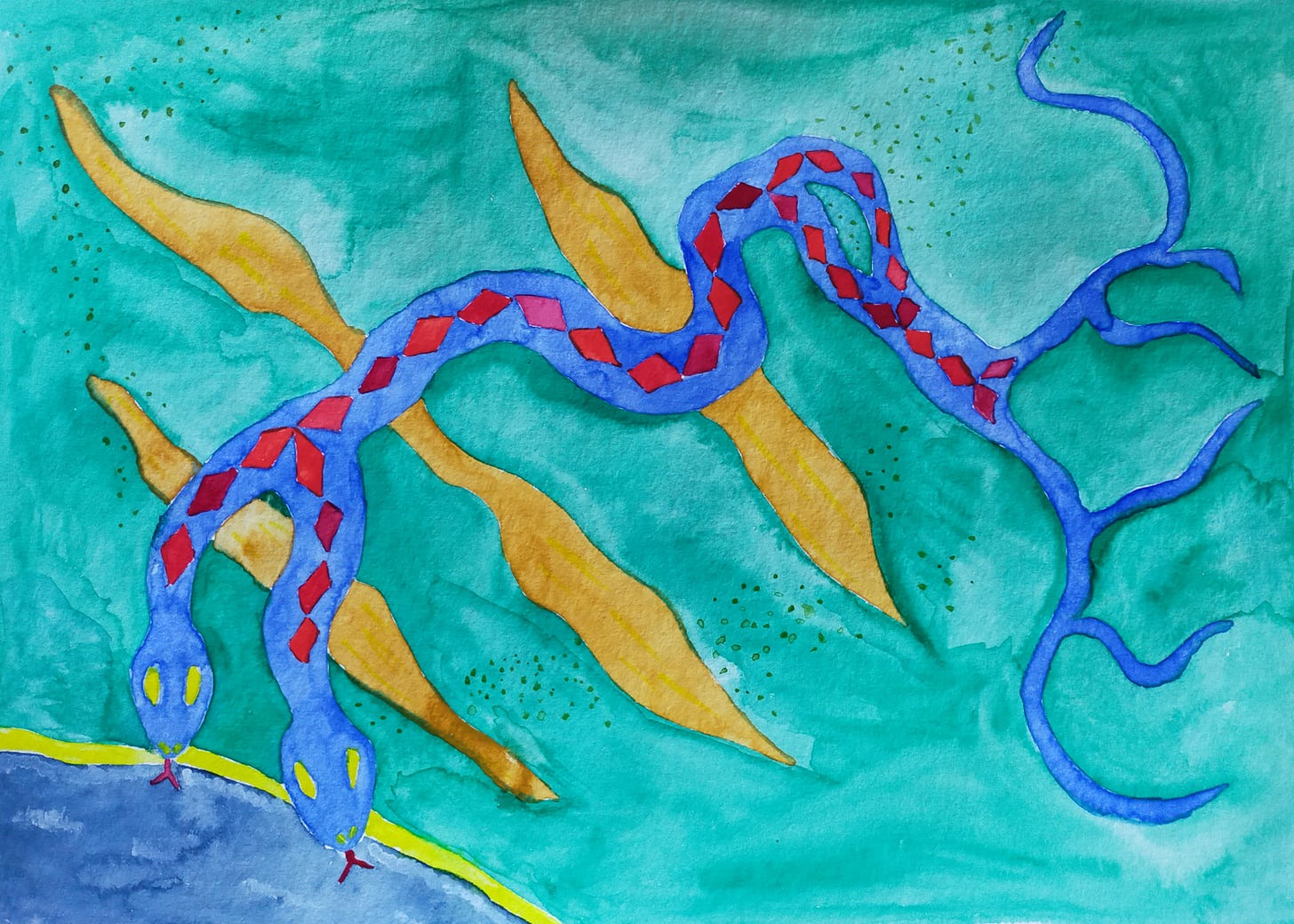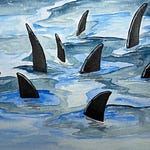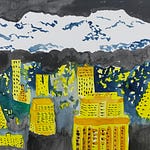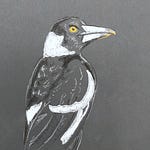Every drop of water that falls from the sky and traces a pathway down the creek to the river and from there through the estuary to the sea, that freezes in sheets of sea ice, or melts from the edge of a glacier, every drop we sip from a cup, bathe or swim in, each one has been here since time immemorial; much of it older than the earth itself.
Water is a master rejuvenator, shapeshifting as it journeys over billions of years. Who else pressed it to their lips, sucked it through its roots, or flushed it into the sewer. Ancient beasts, extinct Gondwana forests, deep sea creatures. You. Humans are, on average, 60% water. It flows in and out of our bodies, sustains us, and when we die, it leaves us to continue its journey, vapourising into the sky or travelling through the ground where it is filtered and returns to us anew. Water pulses through every living thing. It is the one thing that connects all life on earth—not even oxygen can do that. You could very well be drinking the same molecule that once passed through a dinosaur, or perhaps, the brain of Archimedes. Maybe even his bathwater!
From my window here in the alpine valleys of Victoria I see glimpses of the clear-water creek that carved this tight valley. Its ripples shimmer through the scrub and bracken fern as it descends from its source in the Great Dividing Range above my home, springing from underground, melting from the snow, captured by little gullies that funnel it down an arterial network, gathering and growing molecule by molecule until it spills into the Ovens River, cutting between the canyon where whitewater leaps over rocks before twisting and turning among the gums, until it leaves the mountain valleys and enters the flat lands, slows, grows tea brown, and merges with the mighty Murray.
We follow the Murray up past the ancient pink salt lake, through the wispy mallee country and to the arid lands near Mildura, where dust storms colour the sky red and sand whips snakelike across the road as we drive. We are flanked by orchards that spring out of the bare earth. There is no grass. Wild goats picking at saltbush stare as we pass. It’s hard to imagine life here without the river.
A little further west is where the Murray meets the Darling. From this confluence, I could forge my way back to my home some 1,000km away, but if I trace the waters up the Darling almost 2,500km in the other direction, I would pass through New South Wales and be standing at the headwaters of the Condamine in Queensland’s Main Range National Park; a tiny spring so delicate one could stand comfortably with a foot planted either side. I once touched the water here and told it I would see I again in 5,000km when I reached the glistening estuary of the Coorong in South Australia, and that I would sit by its side and watch as it reunited with its old friend the sea.
Heading west, we travel to the Riverlands, where the Murray playfully twists and curls, and then twists and curls again to form a scattering of little islands and lagoons before it banks south toward the coast. At Loxton, it is wide and deep blue, buoying the houseboats and the pelicans.
This one amazing river system covers 14% of Australia’s landmass—over 1 million square kilometres, larger than France and Germany combined. It forms in the ancient Great Dividing Range that stretches for 3,500km; a spine-like protrusion that runs down the country like a giant life-giving serpent, birthing rivers and streams that snake coastward, or inland to bring life to the most inhospitable of places.
We leave the river and head south to Naracoorte—the place of running water in Bindjali. It’s some 90km from the southern coastline of Australia, but the ocean waves once crashed along its shores leaving an ancient sand ridge preserved as the East Naracoorte Range. The ocean swirled underground, too, carving out limestone caves, then when its handiwork was done, receded to form a new shoreline, and a new ridge of sand, a pattern it repeated over a million years as the ice at the polar caps grew and sea levels dropped, leaving behind an alluring display of parallel ranges.
In the caves at Naracoorte rests a graveyard of Pleistocene megafauna. We walk past the skull of a diprotodon, a bunyip-sized wombat that could weigh as much as 2.8 tonnes, and the thigh bones of a giant leaf-eating kangaroo that stood up to 3 metres tall. The ancient stories of Australia’s First Nations peoples tell of these giant beasts which died out some 46,000 years ago. They lived here at the same time. And of these stories, the most enduring and widespread are of a creator being in the form of a giant snake—the Rainbow Serpent—which shaped the rivers and the lakes of this great land. These giant snakes were no myth. Perfectly preserved at Naracoorte is the skeleton of the python-like Wonambi, which grew up to 6 metres long. It sits in a glass display by the ticket desk; hundreds of pencil-thin ribs rapped around the skeleton of a marsupial lion.
We can feel the coast now, its magnetic force drawing us nearer and nearer. It’s useless for an Australian to resist the ocean. And so we let it pull us through the wildest of storms to the small beach cove of Carpenter Rocks. The wind and the rain lash the car as we watch the waves crash with ravenous beauty against the shore. But unlike those that once receded to form the ancient ranges between here and Naracoorte, the ocean is returning. Its white foam fingers stretch across the grass and reach for the road as we leave. It comes within centimetres. This water that was once ice, or rain, or a cloud, or a stream, that was once in a drink or a drain, that was carried by ancient asteroids and the bodies of the living. It moves, it creates, it recycles, it brings life, and it destroys. It knows its way across this land. It knows how to mould it into something new. It’s been here before, many times.
And so I return home to my desk and think about what it is I want to tell you, and lost in thought, a cup of tea pressed to my lips, I look out my window and stare at the creek’s hypnotic ripples of silver light as it runs by. It moves with such certainty, not an ounce of fear or hesitation. It just keeps on its way, it’s journey never ending.
A little update
I’m somewhat sad to say (although a little relieved to lighten the load) that I’m retiring Etymology Monday. I still have my fascination with word histoires, but the time used to write them will be better spent on other things. Behind the scenes, I’m chipping away (albeit, slower than a sloth) at a creative pursuit and my copywriting work is keeping me busy. Last week, a project I was hired to work on won Gold in a state category and will now represent Victoria at the national awards. On another positive note, it appears I’ve become an accidental podcaster. I began releasing the audio recordings of my essays as podcast on the basis of, why not. They’re now substantially more popular than the written copy of my work, so I’m going to run where the wind takes me. My written essays remain my priority, but you will notice each will start with an option to listen (at least, that’s the plan. Let’s see if I can stick to it).
Anyway, I hope you are all well wherever you may be in the world right now. And thank you again for sticking with me. Your support of my work means more than you can imagine.
Thank you for Mind Flexing with me. If you enjoyed this essay, please subscribe on Substack or your favourite podcast app, comment, click the ❤️ button, or share it with someone who would appreciate it. I’ll be back in a fortnight. Until then, keep 💪















